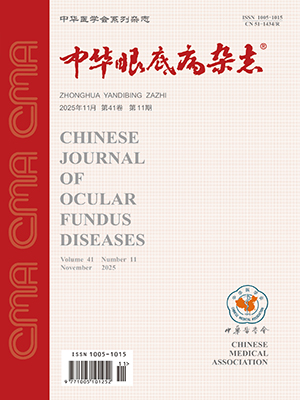| 1. |
Shields JA, Shields CL, Honavar SG, et al. Classification and management of Coats disease: the 2000 Proctor Lecture[J]. Am J Ophthalmol, 2001, 131(5): 572-583. DOI: 10.1016/s0002-9394(01)00896-0.
|
| 2. |
惠延年. Coats病的中文名称应统一[J]. 中华眼底病杂志, 2015, 31(5): 485-486. DOI: 10.3760/cma.j.issn.1005-1015.2015.05.019.Hui YN. The Chinese name of Coats disease should be unified[J]. Chin J Ocul Fundus Dis, 2015, 31(5): 485-486. DOI: 10.3760/cma.j.issn.1005-1015.2015.05.019.
|
| 3. |
Sen M, Shields CL, Honavar SG, et al. Coats disease: an overview of classification, management and outcomes[J]. Indian J Ophthalmol, 2019, 67(6): 763-771. DOI: 10.4103/ijo.IJO_841_19.
|
| 4. |
Dalvin LA, Udyaver S, Lim LS, et al. Coats disease: clinical features and outcomes by age category in 351 cases[J]. J Pediatr Ophthalmol Strabismus, 2019, 56(5): 288-296. DOI: 10.3928/01913913-20190716-01.
|
| 5. |
Nowara M, Fouad YA, Abdel Aziz I, et al. Experience with intravitrealranibizumab as an adjunct to ablation therapy in eyes with exudative Coats' disease[J]. Clin Ophthalmol, 2021, 15: 367-373. DOI: 10.2147/OPTH.S293030.
|
| 6. |
Jiang L, Qin B, Luo XL, et al. Three-year follow-up of Coats disease treated with conbercept and 532-nm laser photocoagulation[J]. World J Clin Cases, 2020, 8(24): 6243-6251. DOI: 10.12998/wjcc.v8.i24.6243.
|
| 7. |
Zhang L, Ke Y, Wang W, et al. The efficacy of conbercept or ranibizumab intravitreal injection combined with laser therapy for Coats' disease[J]. Graefe's Arch Clin Exp Ophthalmol, 2018, 256(7): 1339-1346. DOI: 10.1007/s00417-018-3949-1.
|
| 8. |
Shields JA, Shields CL, Honavar SG, et al. Clinical variations and complications of Coats disease in 150 cases: the 2000 Sanford Gifford Memorial Lecture[J]. Am J Ophthalmol, 2001, 131(5): 561-571. DOI: 10.1016/s0002-9394(00)00883-7.
|
| 9. |
Schulze-Bonsel K, Feltgen N, Burau H, et al. Visual acuities "hand motion" and "counting fingers" can be quantified with the freiburg visual acuity test[J]. Invest Ophthalmol Vis Sci, 2006, 47(3): 1236-1240. DOI: 10.1167/iovs.05-0981.
|
| 10. |
中华医学会眼科学分会眼底病学组. 我国视网膜病玻璃体腔注药术质量控制标准[J]. 中华眼科杂志, 2015, 51(12): 892-895. DOI: 10.3760/cma.j.issn.0412-4081.2015.12.005.Fundus Disease Group of Ophthalmology Branch of Chinese Medical Association. Quality control standard for intravitreal injection of retinopathy in China[J]. Chin J Ophthalmol, 2015, 51(12): 892-895. DOI: 10.3760/cma.j.issn.0412-4081.2015.12.005.
|
| 11. |
何晶晶, 孙祖华, 刘晓玲. 局部视网膜激光光凝治疗Coats病的疗效观察[J]. 中华眼底病杂志, 2021, 37(8): 605-609. DOI: 10.3760/cma.j.cn511434-20201010-00487.He JJ, Sun ZH, Liu XL. Efficacy of focal photocoagulation on Coats disease[J]. Chin J Ocul Fundus Dis, 2021, 37(8): 605-609. DOI: 10.3760/cma.j.cn511434-20201010-00487.
|
| 12. |
Toi M, Matsumoto T, Bando H. Vascular endothelial growth factor: its prognostic, predictive, and therapeutic implications[J]. Lancet Oncol, 2001, 2(11): 667-673. DOI: 10.1016/S1470-2045(01)00556-3.
|
| 13. |
Mano F, Matsushita I, Kondo H, et al. Vitrectomy and external drainage of subretinal fluid containing high concentration of vascular endothelial growth factor for advanced coats disease[J/OL]. Sci Rep, 2021, 11(1): 19333[2021-09-29]. https://pubmed.ncbi.nlm.nih.gov/34588604/. DOI: 10.1038/s41598-021-98968-9.
|
| 14. |
Kase S, Rao NA, Yoshikawa H, et al. Expression of vascular endothelial growth factor in eyes with Coats' disease[J]. Invest Ophthalmol Vis Sci, 2013, 54(1): 57-62. DOI: 10.1167/iovs.12-10613.
|
| 15. |
Liang T, Xu Y, Zhu X, et al. Aqueous humour cytokines profiles in eyes with Coats disease and the association with the severity of the disease[J]. BMC Ophthalmol, 2020, 20(1): 178. DOI: 10.1186/s12886-020-01421-0.
|
| 16. |
Stanga PE, Jaberansari H, Bindra MS, et al. Transcleral drainage of subretinal fluid, anti-vascular endothelial growth factor, and wide-field imaging-guided laser in Coats exudative retinal detachment[J]. Retina, 2016, 36(1): 156-162. DOI: 10.1097/IAE.0000000000000669.
|
| 17. |
Kang HG, Kim JD, Choi EY, et al. Clinical features and prognostic factors in 71 eyes over 20 years from patients with Coats' disease in Korea[J/OL]. Sci Rep, 2021, 11(1): 6124[2021-03-17]. https://pubmed.ncbi.nlm.nih.gov/33731773/. DOI: 10.1038/s41598-021-85739-9.
|
| 18. |
Li H, Lei N, Zhang M, et al. Pharmacokinetics of a long-lasting anti-VEGF fusion protein in rabbit[J]. Exp Eye Res, 2012, 97(1): 154-159. DOI: 10.1016/j.exer.2011.09.002.
|
| 19. |
Van Bergen T, Etienne I, Cunningham F, et al. The role of placental growth factor (PIGF) and its receptor system in retinal vascular diseases[J]. Prog Retin Eye Res, 2019, 69: 116-136. DOI: 10.1016/j.preteyeres.2018.10.006.
|
| 20. |
Chiu HH, Wan MJ, Kertes PJ, et al. Visual outcomes after treatment in pediatric patients with Coats' disease[J]. Can J Ophthalmol, 2019, 54(6): 647-652. DOI: 10.1016/j.jcjo.2019.02.004.
|
| 21. |
Liang T, Peng J, Zhang Q, et al. Management of stage 3B Coats disease: presentation of a combined treatment modality and long-term follow-up[J]. Graefe's Arch Clin Exp Ophthalmol, 2020, 258(9): 2031-2038. DOI: 10.1007/s00417-020-04739-z.
|
| 22. |
Ramasubramanian A, Shields CL. Bevacizumab for Coats' disease with exudative retinal detachment and risk of vitreoretinal traction[J]. Br J Ophthalmol, 2012, 96(3): 356-359. DOI: 10.1136/bjophthalmol-2011-300141.
|
| 23. |
Gaillard MC, Mataftsi A, Balmer A, et al. Ranibizumab in the management of advanced Coats disease stages 3B and 4: long-term outcomes[J]. Retina, 2014, 34(11): 2275-2281. DOI: 10.1097/IAE.0000000000000248.
|
| 24. |
Daruich A, Matet A, Tran HV, et al. Extramacular fibrosis in Coats' disease[J]. Retina, 2016, 36(10): 2022-2028. DOI: 10.1097/IAE.0000000000001013.
|
| 25. |
Zheng XX, Jiang YR. The effect of intravitreal bevacizumab injection as the initial treatment for Coats' disease[J]. Graefe's Arch Clin Exp Ophthalmol, 2014, 252(1): 35-42. DOI: 10.1007/s00417-013-2409-1.
|
| 26. |
Bergstrom CS, Hubbard GB 3rd. Combination intravitreal triamcinolone injection and cryotherapy for exudative retinal detachments in severe Coats disease[J]. Retina, 2008, 28(Suppl 3): S33-37. DOI: 10.1097/IAE.0b013e318159ecad.
|




